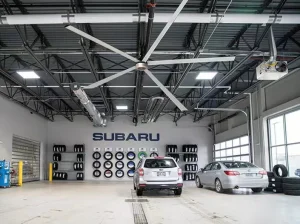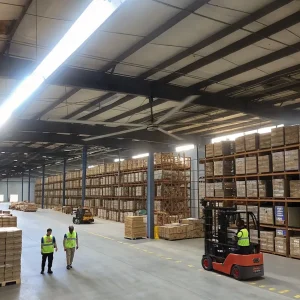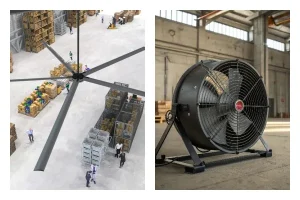Factories, sports centers, and warehouses frequently deal with lingering heat, making it hard for teams to stay productive. The discomfort can escalate costs and stall daily activities. However, an effective cooling method exists: understanding the differences between high velocity fans and low-speed alternatives can transform your environment completely.
Yes, high velocity fans can cool effectively by producing a strong breeze that quickly disperses cool air throughout larger areas. They move air at a higher speed, preventing heat from accumulating and offering rapid relief. Meanwhile, low-speed fans push a high-volume of air gently, covering wide zones with less power usage. Selecting the right fan depends on your space, your airflow goals, and how you balance costs with comfort.

hvls fans application
Innovative fans are designed to provide cooling and ventilation in diverse spaces, whether it’s a busy warehouse or a modest workshop. A high velocity method focuses on pushing a lot of air at a higher speed, thus creating a noticeable breeze.
One might ask, do these fans truly cool the space? While they don’t chill the air in the same way an air conditioner does, high velocity fan models expel warm air and bring in cooler air, producing a more comfortable environment. By generating rapid air movement, they reduce the sensation of heat. For environments with low humidity, the effect can feel especially refreshing.
This approach works because hot air rises, forming warm pockets near ceilings. A fan could disturb those layers, mixing fresh, possibly cooler air with the surrounding atmosphere. As a result, individuals in the path of the breeze often feel significantly cooler. So, while these fans don’t literally lower the temperature, their cooling effect can be quite impactful.
To cool effectively, you need to weigh the difference between a high-speed industrial fan and a low-speed model, such as hvls fans. Although both can be considered types of industrial fan, their performance differs.
Ultimately, picking one depends on your specific needs. If a facility requires strong, immediate breezes, a high velocity fan might shine. Conversely, if you need consistent, gentle coverage with minimal noise, HVLS stands out.
When you’re dealing with larger spaces like factories, sports arenas, or busy commercial floors, an industrial fan becomes an essential tool for cool comfort. These fans are often used because of their robust construction and capacity to handle heavy workloads.
Many fans are designed for heavy-duty operations. They handle continuous use without overheating, unlike smaller, flimsy models that might fail under intense conditions. As a result, you can keep these fans running alongside your HVAC system to maintain stable temperatures in settings where normal room air can become oppressive.
In a sprawling facility, using just a small box fan or a few smaller fans rarely suffices. Industrial fan technology like HVLS or high-speed units can move a substantial volume of air, ensuring minimal hot spots. When multiple fans coordinate, they help circulate and exhaust warm air, balancing the interior climate.
A floor fan—especially one with high velocity performance—can cool small to medium areas quite efficiently. Pedestal fans and floor fan models with robust motors are well-suited for localized tasks, like drying wet floors or delivering a direct breeze at workstation level. However, they may struggle in extremely large or tall buildings.
If your space is bigger—like an extensive production hall—a single high-velocity floor fan might not meet your cooling solution needs. You might need multiple fans or a complementary overhead system for truly comprehensive air circulation. Also, if you rely on them to exhaust stagnant air, be mindful of how you position them for best results.
One might assume a ceiling fan only works for houses or offices, but in reality, large industrial ceiling systems exist that push tremendous volumes of air. While not all overhead installations are strictly “high-speed,” they still produce a robust breeze that helps cool occupant spaces.
Though a ceiling fan can run at a higher speed, you must ensure it fits your building’s structure. For example, some overhead fans measure many feet in diameter, adopting the high-volume approach that moves air gently. Meanwhile, others revolve faster for a more intense breeze. Either way, these systems help you cool the space by continuously circulating and mixing the air layers.

Large ceiling fan in warehouse
A garage can get stuffy fast, especially if you’re working on vehicles or storing items that generate heat. While an air conditioner might be an option, some find it too costly or inefficient for a partially open structure. Instead, focusing on air movement with fans can help:
Because of typically smaller enclosed areas, a direct, powerful breeze can quickly displace hot pockets. Some high-speed fans are quite portable, so you can angle them toward a car engine bay or point them upward to push heat out through vents or an open window. Running the fan at full blast is helpful when you need immediate relief, but you can also opt for fan at low to maintain a gentle breeze if you’re spending long hours in the space.
Several types of fans exist, but deciding which is best is never one-size-fits-all. High-speed units create intense airflow, ideal for short bursts of cooling in zones that overheat quickly. Meanwhile, low-speed fans (like HVLS) push a high-volume of air more softly.
When you balance the two, you get the best of both worlds: immediate relief for critical stations and broad coverage for general temperature stability. The choice ultimately depends on your specific environment and how quickly you want to air quickly transform conditions.
Many large organizations rely on HVLS (High Volume, Low Speed) technology to cool expansive warehouse floors. These fans produce a consistent breeze that helps stabilize the indoor climate while minimizing power consumption. Because they revolve slowly, they’re less disruptive than smaller, ultra-fast fans.
Many HVLS fans incorporate advanced materials and stable motors that run quietly. This combination of minimal noise and powerful coverage can save businesses from installing multiple smaller units in high-bay facilities. In essence, if you need a broad, reliable breeze, HVLS is a perfect fan approach for a warehouse scenario.
When it comes to picking the fan for your space, you might weigh the merits of a high-velocity fan versus a high-volume approach. Both are strong contenders in cooling larger rooms, so deciding between them often rests on operational specifics.
Neither category is strictly better than the other. In fact, combining them can yield the best outcome. For instance, a high-speed unit near a loading dock might exhaust hot air quickly, while an HVLS system in the center ensures employees remain consistently cool across a larger area.

High speed Fans VS Low speed Fans
frequently asked questions can clear up lingering confusion about how fans operate in real-world environments.
Are high velocity fans better at cooling than regular models?
They do deliver strong breezes, which helps you cool more quickly. However, their success in broader coverage can vary, so you might need multiple fans or complementary solutions for effective cooling in sprawling sites.
Do high-speed fans raise my energy bills?
Running at higher energy levels does draw more electricity, but if used strategically—like short bursts in sweltering corners—this doesn’t necessarily break the bank. Many find them cheaper than installing or running an AC unit full-time.
What about using HVLS fans in extremely tall facilities?
Since fans are usually installed at higher points, HVLS devices excel in spaces where hot air rises. They push down that warm layer, creating a uniform climate. This approach significantly reduces the burden on other cooling equipment.
Is a speed industrial fan always the right answer for big factories?
It really depends on your specific application. Some factories see success with a high-speed industrial fan near heavy machinery and HVLS overhead fans in occupant areas. Blending solutions often yields the best temperature balance.
How do I handle window air exchange with fans?
Setting up a fan to draw in fresh breezes or exhaust warm air out the window can boost comfort, especially if the outside temperature is mild. This technique is particularly effective if you want to avoid or supplement a standard ac unit.
| Fan Characteristic | High Velocity | HVLS (Low-Speed) |
|---|---|---|
| Air Movement | Aggressive, immediate | Gentle, widespread |
| Ideal Use | Spot-cooling, garages and workshops | Larger spaces, wide coverage |
| Power Consumption | Higher when on max fan speed | Generally lower, more energy efficient |
| Noise Level | Moderate to loud, depending on build | Often quieter due to lower speed rotation |
| Best Application | Quick relief, targeted tasks | All-day comfort, broad occupant coverage |
| Benefit for Multi-Purpose Areas | Good for immediate results in certain zones | Uniformly cool the entire space over long hours |
Fan Speed Airflow (Relative) Coverage Area
Low (HVLS) High-Volume Wide and Even
Medium Moderate Mid-Scale
High Velocity Very Strong Targeted Spot
This illustration shows how set the fan speed influences coverage. A fan at low rotation might deliver gentle but consistent coverage, whereas a high velocity setting blasts a narrower region with more intensity.
Imagine a sprawling warehouse storing temperature-sensitive goods. The facility has pockets of heat near shipping areas. Installing multiple overhead HVLS fans helped maintain a consistent climate across most of the floor by effectively circulating air. However, near the loading dock—where trucks arrive with open doors—a dedicated high-speed industrial fan was introduced to push out warm air swiftly and pull in outdoor air on cooler days.
This dual setup drastically improved comfort for workers who said they felt “far cooler and more productive.” Over a quarter, the management team saw a notable dip in energy usage from reduced reliance on mechanical cooling systems. The synergy exemplified how blending high velocity solutions with low-speed HVLS fans can be the perfect fan approach for certain operations.
While discussions often center on high-speed devices, there’s a growing appreciation for the low-speed method, especially in facilities that require cool conditions all day. By adopting HVLS, one can see significant reductions in energy bills without compromising occupant comfort. It’s a strategy that merges cost savings with effective climate management, especially for large buildings like schools, used in warehouses, or commercial spaces.
Many brand options exist, from recognized high-velocity favorites such as lasko to specialized vindus HVLS lines. Providers bring unique expertise for larger spaces, offering tailored designs that ensure you get a fan for your space that meets your needs. The key is choosing the right fan that aligns with your workflow, power consumption goals, and comfort level.
Before deciding on a high-speed or low-speed fan, consider your environment’s size, usage, and staff comfort demands. Evaluate the amount of air you need to move and whether you require continuous coverage or intermittent bursts. By doing so, you’ll confidently pick a system that merges energy efficiency, occupant safety, and day-to-day practicality—ensuring a truly cool and inviting workplace for the long term.

Hi, I’m Michael Danielsson, CEO of Vindus Fans, with over 15 years of experience in the engineering and design industry. I’m here to share what I’ve learned. If you have any questions, feel free to contact me at any time. Let’s grow together!